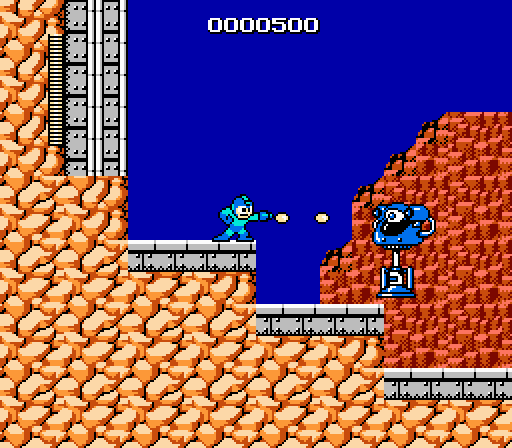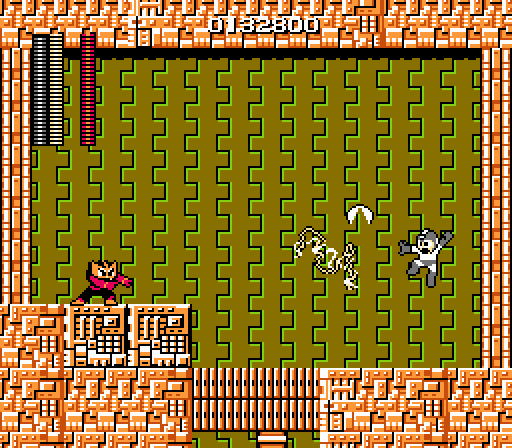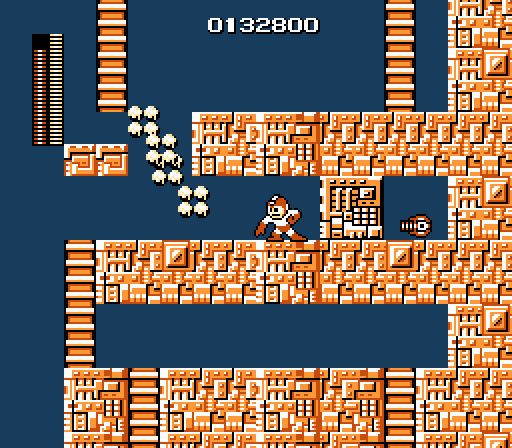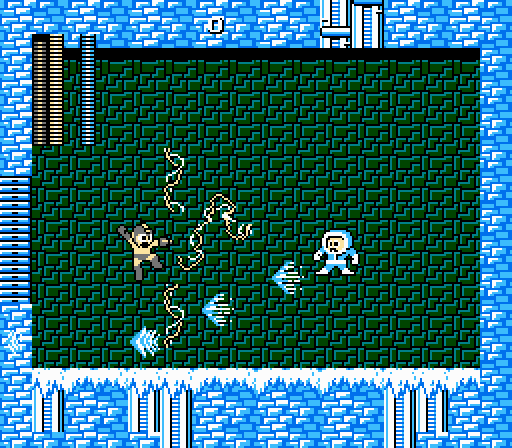Even more important in the equation of how to play Mega Man than the cues provided by the level design are the workings of the titular hero himself. While Mega Man does indeed emerge into this world with a terribly minimal move set, that alone doesn’t define the limit of his abilities. The entire premise of the entire Mega Man franchise, regardless of which series we’re talking about here, is that “Mega Man” in every incarnation possesses supposedly limitless potential.
This being a video game, of course, that doesn’t mean he has limitless potential as an artist or undertaker or ballerina or politician. Or maybe he does? But all he does with that infinite sense of possibility is blow things up. Mega Man wields the ability to mimic the capabilities of other robots, which in video game terms means that when you beat one of the six Robot Masters, Mega Man acquires the ability to use their weapon (or at least a variant version of it). Each weapon you add to his repertoire operates on its own energy meter, which can be refilled by collecting a weapon power capsule, completing a stage, continuing, or certain other factors. Some master weapons are more practical in combat than others, and many of them have unique tool-like capabilities.
However, the master weapons possess another important trait: Each of them is super-effective against at least one of the other Robot Masters. The clue is in Mega Man‘s Japanese title, Rockman. The special weapons operate within a rock-paper-scissors circle of weaknesses, though here you have six variables to deal with instead of three. The principle remains the same, though: Acquire one Robot Master’s weapon and you suddenly gain the upper hand against another. A key element of playing a Mega Man game comes in figuring out exactly which boss is easiest to defeat with Mega Man’s default blaster and the proper sequence in which to tackle subsequent stages from there. By the end of this game, Mega Man can still run, jump, climb, and shoot in two directions. But he can also chuck bombs, belch fire, freeze enemies in midair, toss rocks, and more. While the master weapons mainly come in handy against Robot Masters here, they do have a number of situational uses as well.
P
Mega Man’s default weapon is the only one that carries infinite energy. As long as Mega Man hasn’t been blown up, he can use the cannon built into his arm. In the menu screen, it’s designated with the letter P, which means… well, no one knows, actually. Plasma? Projectile? Pitiful? Peashooter?
Peashooter is the most fitting moniker, if admittedly the least likely. The arm cannon’s default attack consists of a stream of small, oblong pellets with a slightly yellow cast. In a nice touch, weapon energy capsules cycle through colors to reflect Mega Man’s current power – he changes colors when he swaps out for different weapons – and the P cannon, which operates off Mega Man’s internal battery or whatever, fires projectiles that are the same color as health capsules. Mega Man can fire up to three Ps (peas?) at a time. The projectiles pass through all objects except enemies, which either absorb the bullets as they take damage or reflect them back at an oblique angle.
There are very few enemies the P cannon can’t harm. All Robot Masters are vulnerable to the gun, though some of them deal such disproportionate damage in return that there’s no sense in going head-to-head against them without something better, unless you just have something to prove. Armored or shell-covered foes are completely safe from Mega Man’s basic cannon fire until they expose their weaknesses.
While not a powerful weapon, the P cannon proves to be extremely versatile. As is fitting for the game’s basic weapon, it’s useful in nearly any situation, though not always optimal. Much of the strategy of the game boils down to determining when a different weapon has more utility, and balancing energy usage for those alternate tools.
Rolling Cutter
Essentially a boomerang that looks like Pac-Man, you acquire the Rolling Cutter from Cut Man. While moderately more powerful than the P cannon, Rolling Cutter has two advantages: First, Elec Man is almost impossible to defeat without it. Second, the Rolling’s path describes an arc when you throw it. It rises up, curves back downward, makes a sharp U-turn while continuing to drop, and finally twists back upward as it returns to Mega Man. Or rather, returns to its starting position; if you move after firing a Rolling Cutter, it will return to the point from which it was thrown instead of tracking Mega Man’s movement like, say, the boomerang in Zelda.
The looping movement of the Rolling Cutter makes it situationally useful, primarily for hitting low enemies. Because the blade’s hit box is much, much larger than those (P)uny little bullets the default weapon fires, it covers quite a wide swath of screen as it flies. It may swing wide of small enemies directly in front of Mega Man, but it has a remarkably large effective area. Really, where it comes in handiest is in dealing with small enemies who are too low for Mega Man’s standard attack to hit – basically, the Spines that show up early in Elec Man and Ice Man’s stages.
By no small coincidence, Rolling Cutters are the one weapon that works against them rather than simply stunning them. Also not a coincidence: Elec Man is weak to Rolling Cutter, and his stage begins with a throng of Spines, which can be destroyed with Rolling Cutter. This is a conspicuous tip. If you can clear out the first screen of the stage, you’re properly equipped to take out the boss.
Super Arm
The Super Arm, acquired from Guts Man, is the most situational weapon in the game. It does not allow Mega Man to perform any sort of direct attack by its own nature. It has no ammunition, and it doesn’t let you punch dudes. Instead, the Super Arm only allows you to lift and throw certain objects – special boxes located in specific places throughout the game. Without those boxes present, the Super Arm is 100% useless.
Even when you do find the requisite boxes, the Super Arm comes with severe limitations. Once you lift a box, all you can do is stand in place or throw it. You can only throw it straight ahead, which will cause it to shatter into multiple fragments that fly forward in a predetermined and (somewhat) wide spread. But that’s about it. Once you run out of boxes, you’re pretty much back to being helpless. Guts Man, of course, doesn’t have to deal with this limitation. So maybe Mega Man doesn’t command quite as many infinite possibilities as the rumors suggest.
The Super Arm does come in very useful in two locations where boxes form deliberate obstructions. However, you can also use the Thunder Beam to shatter boxes, so… Super Arm is kind of lame.
Thunder Beam
Speaking of the Thunder Beam, it is by far the most ludicrously powerful weapon in the game. It’s as devastating as Super Arm is worthless. And you know this to be true as soon as you acquire it, because Elec Man can destroy you in three shots, which he fires off in rapid succession.
But unlike Super Arm, Thunder Beam is even more amazing in your hands than in its original owner’s. While Elec Man can blast you with rapid bolts of electricity, when you use Thunder Beam it shoots in three directions at once. Mega Man doesn’t have many options for vertical attacks in this game, so the tripartite capabilities of the Thunder Beam prove to be extremely valuable – especially in stages where you’re climbing ladders (though admittedly the first of the two big instances of this comes at the beginning of Elec Man’s stage, which obviously means you won’t have acquired his weapon yet). It’s both powerful and versatile, capable of hitting enemies that would otherwise be unreachable.
Not only does the Thunder Beam pass through walls, it also passes through enemies rather than being absorbed. This ties in with the game’s most infamous exploit, which takes advantage of the Thunder Beam’s persistence, long length, and the fact that damage against foes is registered anew each time you unpause the game to allow you to destroy any enemy that takes damage from the Thunder Beam in a single shot by rapidly pausing and unpausing the game. But, honestly, even without this particular cheat, it’s still the most devastating item in Mega Man’s arsenal.




Clearly you should have used your precious interview time with Inafune asking him what “P” stood for. 😉
Dammit!
I’m guessing it stands for “Power”, since that’s usually what “P” stands for in video games (i.e. the “P meter” in SMB3). But who knows 😛
Mega Man’s battle cry (in the ’94-’95 cartoon, anyway) was “PLASMA POWER”, so I’d say that’s the most likely answer.
That cartoon is really not high on my list of resources for getting inside the game developers’ heads.
Probably a lucky thing, there, since officially they’re “solar bullets”. Maybe that translates to plasma somehow, but…
First, kudos to the title if it a reference to a Cutting Crew song.
Second, I had always read that Rockman referred to a musical reference. Wouldn’t it be called Jankenman if this was the case? But you talked to Inafune, so maybe you have more insight?
Third, as much as the weapons were handy, I never felt like using them in the stages. Maybe I was just too conservative and wanted to make sure they were fully charged when I entered the boss rooms. Or maybe I was just annoyed at having to go to the submenu to switch weapons back and forth. Or maybe I only ever found the Thunder Beam all that helpful. In any case, I am curious if others actually used the weapons in the levels.
Great approach to Mega Man in these articles. It is a nice, fresh approach to the game.
I intended it as a Pink Floyd reference, but sure. The janken influence on the series’ concept has been cited and referred to many times. As for weapons, I use them much less here than in other games, but the have their place. Certain enemies are much easier with the right weapon, and I always use the Ice Slasher to freeze Big Eyes in midair in Wily Stage 1 so I can run beneath them safely.
I thought you were referencing Henry Ford, to which I was going to reference the Ruby-Spears Mega Man cartoon, where acquiring weapons would turn Mega Man any color you like, as long as it’s blue.
Consider that Cutman is the obvious first boss to tackle, and rock beats scissors.
And also if you do the weakness thing with Cut Man, his weakness is literally getting his face smashed in with a giant rock.
I always use Fireman against the little helicopter enemies, and then in the descending part of Wily 2. Elecman is good for the first rooms of Wily 3, because you can get rid of the roof turrets right away.
I don’t think I’ve ever used the bombs in a level, though. I hardly ever even use them against Gutsman…
Mega Man is one of the games from the franchise I haven’t played very much, but from the look of things, the Thunder Beam completely obsoletes the Rolling Cutter?
Isn’t the name of Guts Man’s weapon Super Arm instead of Guts Arm?
Er, whoops. Yes. My mistake, I wrote this at the airport.
Spoilers for the next weapon update I guess, but one thing I find a little odd about the original Mega Man compared to the rest of the series is that how aside from boss weaknesses and functions like block breaking, the only real difference between most of the boss tools is the way they were fired. Cut Man has the arcing boomerang shot, Elec Man has the three-way spread, Fire Man has a wide shot, and Bomb Man has bombs you throw on the ground that explode after a few seconds, but functionally they all do the same damage against regular foes unless you’re actively exploiting glitches.
The only outliers in Robot Master weapons are Gutsman’s and Ice Man’s. The former’s powerful but the reliance on a very small supply of in-game blocks to actually do anything greatly cripples its utility (it’s basically the Dominion Rod of the Mega Man series), while the latter does no damage but freezes things, which is only really handy when you want to avoid combat or freeze fire columns.
Heh, is “Peashooter” really less likely to be what P stands for than “Pitiful?” 😉
Over the years I tended to assume that “P” meant player, since many games used a solitary P to mean player and because it was next to the health bar.
It’s only in the last year I’ve caught up with Mega Man 1 & 2 on VC so it’s nice to read these and have the details relatively fresh. However, I did play Chip & Dale to death at (or near) the time so the engine felt familiar. Perhaps an overview of the other Capcom games that used or modified the Rockman engine would make an interesting read? Chip & Dale feels very much like Mega Man Lite but it had some 2-player lift-and-throw mechanics. I haven’t played DuckTales or Darkwing but they must have their charms.
Anyway, thanks for these pieces Jeremy. One day I play to sit and play through Super Metroid with your Anatomy as a guide of sorts.
I’m almost certain you can kill Spines with bombs, it’s just harder to time than Rolling Cutter.